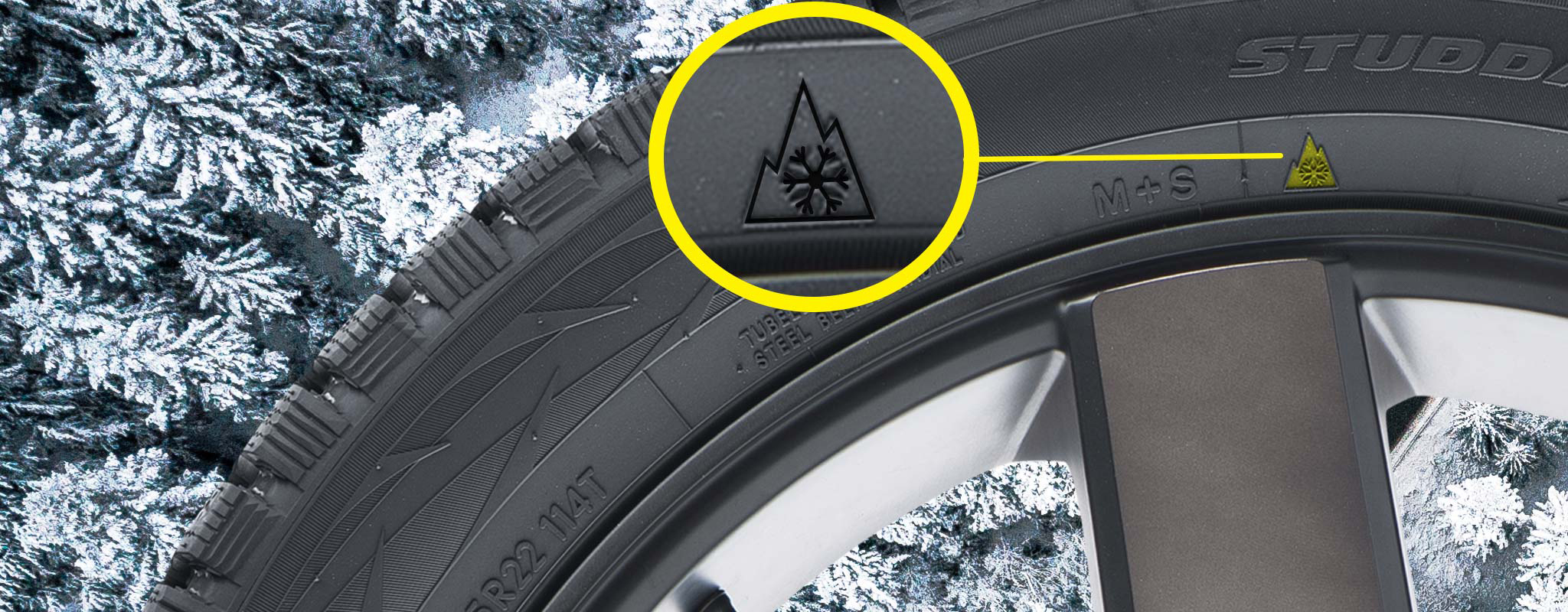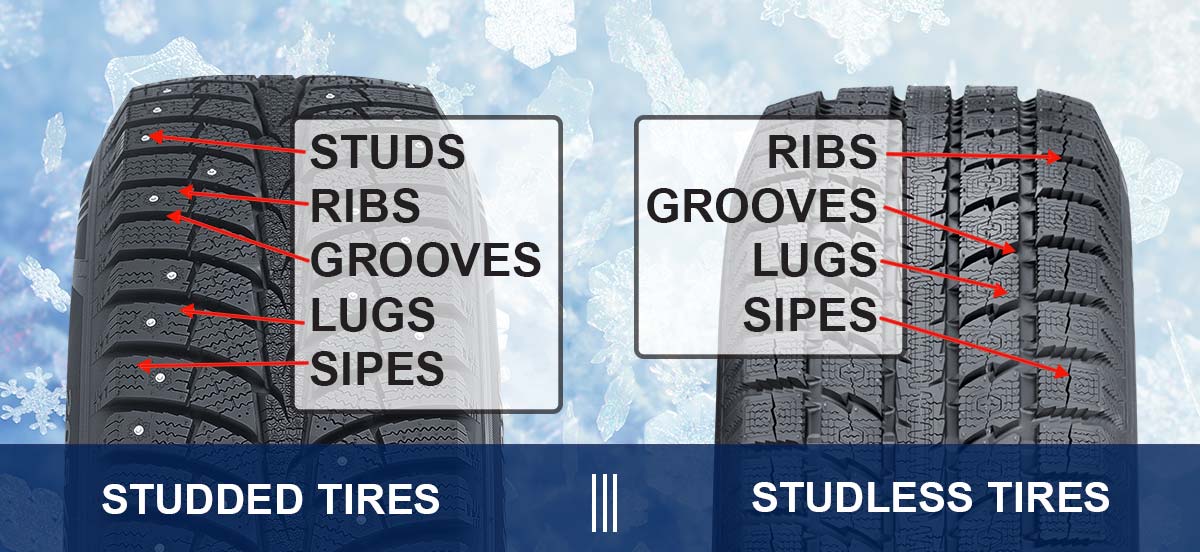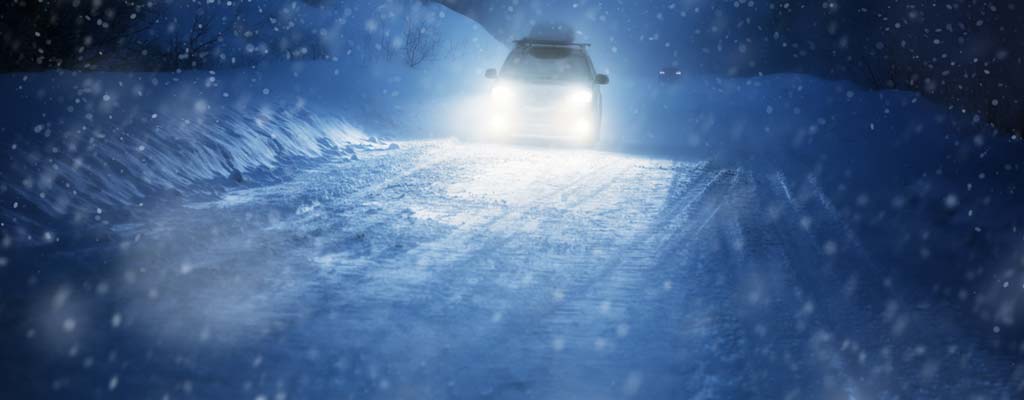What Are Studded Tires & When Should You Use Them
If you’ve ever driven through a winter storm, you know it can get a little tense. Especially when roads are covered in snow and ice. You might not be able to avoid winter, but you can be ready for it with a set of winter or snow tires, including studded options. We have some tips to help you make the right choice about studded winter tires, how studs keep you in control, and when they can be used in your state.
What Are Studded Tires?
Studs are lightweight, small metal spikes (studs) that are staggered and inserted across the tread of a winter tire. These studs protrude slightly from the rubber tread surface, helping break through packed snow and ice-covered roads to give you better traction. Note: Extra tread depth is needed to accommodate studs, so studded tire size options are often limited.
How & Where Do Studded Tires Work?
A good set of tires is essential for winter driving, whatever the weather. If you’re heading into snow and ice, studded tires can have a big impact on your safety. A vehicle equipped with winter traction tires can stop faster on ice than a car without those tires — even if you’re driving just 15 miles per hour.
Studded tires work best on snow and ice-covered roads that have yet to be fully plowed. As the studs pierce the ice and snow, they provide extra traction to keep you safe and in control.
Why Are Studded Tires Used For Winter Driving?
Snow tires, and especially studded winter tires, are specifically designed to help you stay on the road in snow zones or mountain regions where the temperature regularly drops below 40 degrees. Snow tires are distinguished by a mountain snowflake symbol on the sidewall of the tire. This indicator means the tires have been tested and proven for snow, ice, and slush.

The benefits of snow tires include improved traction, vehicle handling, and skid control thanks to deeper, wider, and more jagged tread than regular tires. This tread allows the tire to pick up snow and maintain traction. The studs on some of those tires give them added grip on snow and ice.
Are Studded Tires Always the Best Option for Winter?
Studded tires are not always the best option for safe winter driving. Studded tires provide optimal traction on ice or packed snow. But studless winter tires work well on slush and packed snow thanks to wide, deep grooves in the tread and lots of irregular surfaces with sharp edges. These allow the rubber to cut through the snow and grip the road.
As temperatures steadily rise, it’s time to replace your winter tires with all-season or performance tires. We recommend swapping back when you do not plan to drive on snow or ice-covered roads, or when nighttime temperatures are consistently 50º F. As temperatures rise, the special rubber compound found in winter tires can wear out much faster.
Les Schwab Tip: If your winter tires have studs, your state has specific dates those tires must be removed from your vehicle. Find your state’s information here.
Les Schwab can help you choose the right winter tires for where you drive, including a good knowledge of local state laws.
What’s the Difference Between Studded and Studless Tires?
Winter tires are designed to provide extra traction and control on snow and ice. The differences between studded and studless winter tires go beyond tiny metal studs.
Studless snow tires offer great traction for most winter conditions without the metal spikes. Wide, deep grooves in the tread help keep you in control.
Studded tires have spikes or studs that break through packed snow and ice for added traction.

When Can I Use Studded Tires & When Do I Have to Remove Them?
If you do choose a set of studded winter tires for your vehicle, remember there are state-by-state laws regulating when and where you can use them. U.S. states that do allow studded snow tires permit their use from mid-winter to early spring. Driving outside specified dates can carry a steep fine along with plenty of disapproving looks from your fellow drivers.
Stud Laws by State
Studded tire use is regulated by each state. Driving with studded tires on clear roads not only wears down your studs, it can also decrease stopping distance. That’s because your tread is not making optimal contact with the road — your studs are.
For legal stud dates in your region, check out this state-by-state list of studded tire regulations as reported by the U.S. Tire Manufacturers Association.
How Much Do Studded Tires Cost?
The price for a set of studded winter tires depends on the size of tire you need for your vehicle, the features of those tires, the warranty, as well as other options. The experts at Les Schwab can help you choose the right winter tires for your car or truck.
Are Studded Winter Tires Right for You?
Depending on where you drive and the winter conditions you face, studded winter tires could add safety to outings in tough winter conditions. Studded or regular winter tires could be a good choice if you’re a winter sport enthusiast, often navigate unmaintained winter roads, or if you plan to drive in the snow and ice every week. The pros at Les Schwab can help you face winter with the right tires.
Let Les Schwab Help You With Your Studded Tire Needs
The right set of winter tires can be found at your local Les Schwab. Stop by today or schedule an appointment and we’ll help you decide on the best winter traction to keep you in control and safely on the road.
